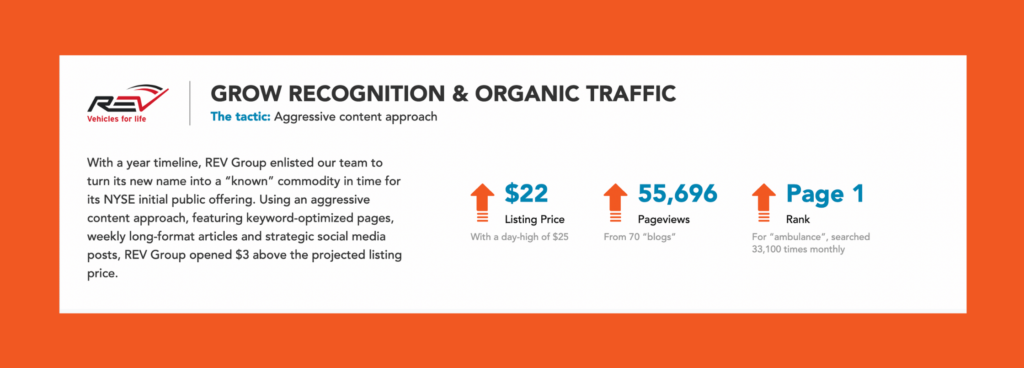Whether you’re bringing a new product line to market or walking through the acquisition of a new business, a solid multi-brand marketing strategy is the foundation for growing a healthy business that supports more than one brand.
It determines your identity, communications plans, and growth objectives moving forward. And it’s where we tell all our clients with growing brand portfolios to start.
In this post, we’ll unpack what multi-brand strategy actually is, what it could mean for your business, and how to ensure success across multiple, healthy brands.
What is Multi-Brand Strategy?
Multi-brand strategy is the decision by an organization to market two or more brands in the same product segment. Proctor & Gamble is a great, traditional example. They sell at least 9 different laundry detergent brands, including Tide, Gain, and Cheer.
Why? Because P&G believes it can increase its market share by selling each brand to different audiences. Different price points. Different sensitivities. The same is true for companies like Volkswagen, with brands for very different drivers including Audi, Lamborghini, and VW.
Multi-brand strategy is also at play when a business or holding company supports a portfolio of multiple brands in different product segments or industries altogether. Take Nestle for example, with more than 2,000 brands from baby food to pet care. Or SONY, which holds companies in industries ranging from film and entertainment to biotechnology.
To manage and market more than one brand effectively requires a very different marketing strategy—and a broad bandwidth. But, when launched with intention and focus, it’s definitely worth it.
Benefits of Multi-Brand Strategy
While each of these instances calls for a slightly different playbook, the benefits of an effective multi-brand strategy remain the same. Let’s explore six major benefits to marketing multiple brands:
- Strengthen Your Position as a Market Leader
- Increase Your Market Presence
- Enhance Your Ability to Cater to Customers who Like Brand Diversity
- Build Healthy Internal Brand Competition
- Increase Cross- and Upselling Opportunities
- Enjoy Improved Customer Data
Strengthen Your Position as a Market Leader
When your brand is truly relevant, your market awareness and customer loyalty will continuously grow. With positive brand recognition comes trust, and that trust translates into a willingness to try a new brand or product that you introduce to the market. And just like that, you have an audience that is willing to transfer their perceived value of your brand to your new products.
With positive brand recognition comes trust, and that trust translates into a willingness to try a new brand or product that you introduce to the market.
Increase Your Market Presence
Let’s take a look at REV, the parent company of more than 20 specialty vehicle brands. Operating as a house of brands, each brand receives individualized positioning and marketing, including the parent company. This strategy allows REV to hold market dominance in multiple sectors of the specialty vehicle industry, including fire trucks, EMS vehicles, motorhomes, and yard trucks—to name a few. The company holds trusted brands, with loyal customers and therefore, easy access to growth. So, as each brand grows, REV too grows.
REV’s house of brands strategy also allowed the company to boost its overall value before going public. When they came to us to turn their parent company into a “known” commodity, we were able to leverage their holdings to earn an opening price $3 above the projected value.

Enhance Your Ability to Cater to Customers who Like Brand Diversity
Let’s face it. People brand hop. Owning multiple brands allows you to satisfy your customers’ urge to try something new while staying within your collection of companies. Once your customers have had a good experience with one of your brands, they may even be more likely to try another brand under your umbrella.
Build Healthy Internal Brand Competition
From a management perspective, competition can be a good thing—improving the performance of each brand within your portfolio. As sub-brands compete against sister brands, each improves productivity, creativity, and resourcefulness. Lessons learned in one area of the business can be shared and translated to avoid the same learning curve. This drives performance across the board and plants the seeds for strong profits.
Increase Cross- and Upselling Opportunities
Acquiring additional brands means expanded customer reach. With each new brand comes an opportunity for cross-selling and upselling, especially if the parent company holds complementary businesses. Consider, once again, REV. With five different brands under its commercial vehicle division, the company is able to provide a streamlined discovery process for municipalities in search of industrial vehicles.
For example: should ENC, a REV Group brand, win a contract with a city to supply public transportation buses, then sister brand COLLINS, has a strong foot in the door to secure municipal contracts for school and other activity buses.
With a cohesive presence among brands, they were able to keep customers in their network of trust—and revenue stream.
Enjoy Improved Customer Data
The bigger the data pool, the stronger the conclusions. Multi-brand businesses have access to a wider cast of customers, and the data from each product line can be aggregated and analyzed across the entire business. Improved insights can bolster marketing campaigns and personalization efforts, which is a must in today’s market. In fact, a recent McKinsey study showed companies growing faster than their competitors drive 40% more of their revenue from personalized campaigns.
Barriers to Multi-Brand Strategy
Even with all these benefits in mind, there are no guarantees in today’s market. And multi-brand strategies can run as much risk as single-brand strategies. It’s important to be aware of the potential roadblocks that come with multi-brand marketing, so we can be prepared to address them head-on.
A lack of brand differentiation is often seen as the biggest risk for multi-brand companies. Without truly setting each brand apart, they can compete for the same audience and cannibalize sales in the process.
Multi-brand businesses must focus on audience targeting, voice differentiation, and using the right channels of communication to truly build relevance with new audiences.
Multi-brand companies also run a risk of credibility loss. If a customer decides they no longer wish to buy from Company A, or Company A’s reputation slips in the market, some may decide the same for the other companies in your house of brands—if they know about the shared ownership.
Clear Branding & Messaging Keeps Multi-Brand Companies Moving Forward
With clear identities for each brand and audience, you can begin to build and maintain brand relevance across your portfolio, avoiding the pitfalls of in-house competition and risks to your reputation. With a strong multi-brand marketing strategy in place, you can reach your market share goals and enjoy a well-rounded portfolio of complementary businesses that grow more relevant together.
Stay tuned for more on Multi-Brand Strategy, including best practices for creating an exceptional multi-brand experience!
